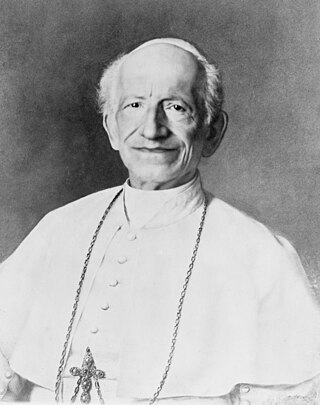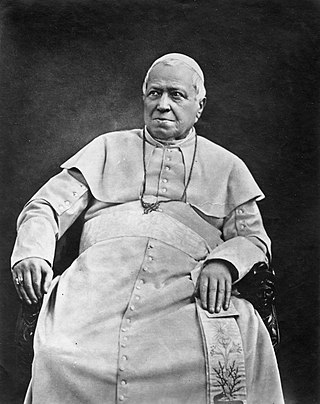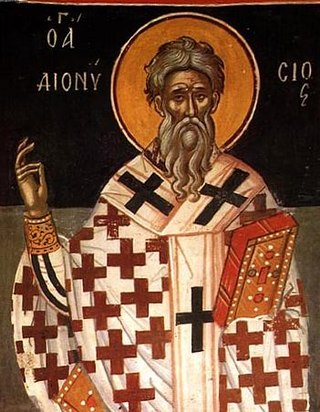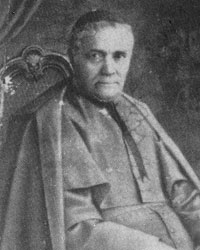Notes
- ↑ Coppi, Antonio Annali d'Italia dal 1750 al 1861, Volume 4, p. 535 Google Books - full view
- ↑ Rivista contemporanea, Volume 10, Torino 1857 Google Books - full view
Prince Annibale Simonetti was a Roman nobleman from nineteenth-century Italy. He was born in Ancona and was related to the Osimo-Jesi branch of the Simonetti. He was assistant to Pope Pius IX, member of parliament and member of the high council of Rome. [1] As a young man in 1848 he was appointed Minister of Finance of Pope Pius IX. [2]

The Council of Trent, held between 1545 and 1563 in Trent, now in northern Italy, was the 19th ecumenical council of the Catholic Church. Prompted by the Protestant Reformation at the time, it has been described as the embodiment of the Counter-Reformation.

The First Ecumenical Council of the Vatican, commonly known as the First Vatican Council or Vatican I, was convoked by Pope Pius IX on 29 June 1868, after four years of planning and preparation. It opened on 8 December 1869 and was adjourned on 20 October 1870 after the Capture of Rome. This was the 20th ecumenical council of the Catholic Church, held three centuries after the Council of Trent, Unlike the five earlier general councils held in Rome, which met in the Lateran Basilica and are known as Lateran councils, it met in Saint Peter's Basilica in the Vatican, hence its name. Its best-known decision is its definition of papal infallibility.

Pope Pius IV, born Giovanni Angelo Medici, was head of the Catholic Church and ruler of the Papal States from 25 December 1559 to his death in December 1565. Born in Milan, his family considered itself a branch of the House of Medici and used the same coat of arms. Although modern historians have found no proof of this connection, the Medici of Florence recognized the claims of the Medici of Milan in the early 16th century.

Pope Leo XIII was head of the Catholic Church from 20 February 1878 to his death in July 1903. Living until the age of 93, he was the oldest pope holding office, and the second-longest-lived pope in history after Benedict XVI as pope emeritus. He also had the fourth-longest reign of any pope, behind those of St. Peter, Pius IX and John Paul II.

Pope Pius IX was head of the Catholic Church from 1846 to 1878, the longest verified papal reign. He was notable for convoking the First Vatican Council in 1868 and for permanently losing control of the Papal States in 1870 to the Kingdom of Italy. Thereafter, he refused to leave Vatican City, declaring himself a "prisoner of the Vatican".
Pope Hyginus was the bishop of Rome from c. 138 to his death in c. 142. Tradition holds that during his papacy he determined the various prerogatives of the clergy and defined the grades of the ecclesiastical hierarchy.

The Syllabus of Errors is the name given to a document issued by the Holy See under Pope Pius IX on 8 December 1864, as an appendix to the Quanta cura encyclical. It condemns a total 80 of what the pope considered as errors or heresies, articulating Catholic Church teaching on a number of philosophical and political questions.

The Solemnity of the Immaculate Conception, also called Immaculate Conception Day, celebrates the sinless lifespan and Immaculate Conception of the Blessed Virgin Mary on 8 December, nine months before the feast of the Nativity of Mary, celebrated on 8 September. It is one of the most important Marian feasts in the liturgical calendar of the Roman Catholic Church celebrated worldwide.

The papal conclave held from 2 to 6 February 1922 saw Cardinal Achille Ratti elected to succeed Benedict XV, who had died on 22 January 1922. It took fourteen ballots for the 53 of the 60 cardinals assembled in the Sistine Chapel to elect a new pope. Ratti took the name Pius XI and immediately revived the traditional public blessing from the balcony, Urbi et Orbi, which his predecessors had eschewed since the loss of Rome to the Italian state in 1870.

Dionysius the Great was the 14th Pope and Patriarch of Alexandria from 28 December 248 until his death on 22 March 264. Most information known about him comes from his large surviving correspondence. Only one original letter survives to this day; the remaining letters are excerpted in the works of Eusebius.

Gaetano Moroni was an Italian writer on the history and contemporary structure of the Catholic Church and an official of the papal court in Rome. He was the author of the well-known Dizionario di erudizione storico-ecclesiastica.

The Roman question was a dispute regarding the temporal power of the popes as rulers of a civil territory in the context of the Italian Risorgimento. It ended with the Lateran Pacts between King Victor Emmanuel III of Italy and Pope Pius XI in 1929.

The Simonetti family is an Italian noble family with origins in Tuscany. During the 12th Century different branches in Florence, Terni, Lucca, Pistoia and Pescia developed. Other famous branches of this family were established in Jesi, Palermo, Milan and Bologna.

Pietro Tenerani was an Italian sculptor of the Neoclassic style.

The history of Catholic Mariology traces theological developments and views regarding Mary from the early Church to the 21st century. Mariology is a mainly Catholic ecclesiological study within theology, which centers on the relation of Mary, the Mother of God, and the Church. Theologically, it not only deals with her life but with her veneration in life and prayer, in art, music, and architecture, from ancient Christianity to modern times.

The Mariology of the popes is the theological study of the influence that the popes have had on the development, formulation and transformation of the Roman Catholic Church's doctrines and devotions relating to the Blessed Virgin Mary.

Ubi primum is an encyclical of Pope Pius IX to the bishops of the Catholic Church asking them for opinion on the definition of a dogma on the Immaculate Conception of the Virgin Mary. It was issued on February 2, 1849.
Peter Joseph Elvenich was a German Catholic theologian and philosopher born in Embken, a village that today is part of Nideggen, North Rhine-Westphalia. He was a principal supporter and defender of Hermesianism, a theological belief system based on the teachings of Georg Hermes (1775–1831).
The Law of Guarantees, sometimes also called the Law of Papal Guarantees, was the name given to the law passed by the senate and chamber of the Italian parliament, 13 May, 1871, concerning the prerogatives of the Holy See, and the relations between State and Church in the Kingdom of Italy. It guaranteed sovereign prerogatives to the Roman Pontiff, who had been deprived of the territory of the papal states. The popes refused to accept the law, as it was enacted by a foreign government and could therefore be revoked at will, leaving the popes without a full claim to sovereign status. In response, the popes declared themselves prisoners of the Vatican. The ensuing Roman Question was not resolved until the Lateran Pacts of 1929.

Antonio Maria Panebianco was an Italian prelate of the Catholic Church. He became cardinal in 1861 and held several senior positions in the Roman Curia.